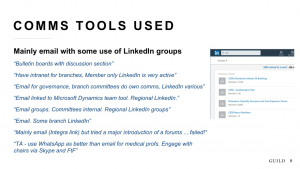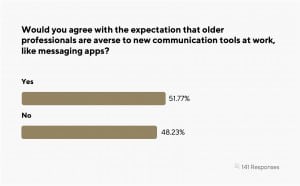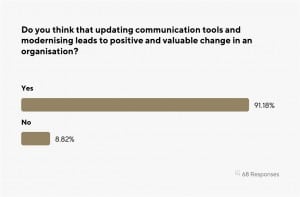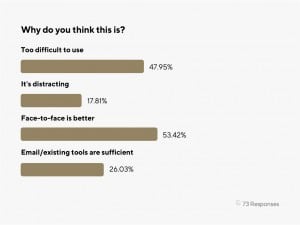By Guest Blogger:
Matilda Strachan, Account Manager
Guild recently conducted research with 33 professional membership organisations in an attempt to further understand their current challenges, specifically in the context of communication with and amongst their members.
The issue of modernisation was a recurring theme, establishing three main areas that any membership body should think about addressing: digital transformation, a generational gap amongst members, and tools used within the organisation.
While the need to modernise was not questioned, the execution of it appeared not to be quite so simple, particularly in the case of communication tools. The above responses comprise the executive teams of the organisations, mostly managers of communications, membership, training, editorial, and marketing.
The above responses comprise the executive teams of the organisations, mostly managers of communications, membership, training, editorial, and marketing.
A manifest shift toward email and forums was at one time certainly a modern push, but has evidently stagnated in many organisations. Emails are easily left unanswered, something particularly problematic when organisations have multiple regional branches with disparate executive teams. The forum, while still varyingly successful, doesn’t lend itself to mobile use and is an increasingly long-winded form of communication.
This friction between call and response feels less and less tolerable as mobile messaging becomes ubiquitous.
One conceivable cause of this stagnation might be the different generations of members, and their respective resistance to changing technology and tools. The expectation, understandably, seems to be that older members who have only recently settled into email and forums will be alienated by a move away from these methods. The digital realm is becoming as timeless as the need for communication itself, therefore these online communities are and will continue to be highly valuable. The platforms they exist on, however, need to frequently reviewed to ensure they are evoking this value.
The digital realm is becoming as timeless as the need for communication itself, therefore these online communities are and will continue to be highly valuable. The platforms they exist on, however, need to frequently reviewed to ensure they are evoking this value.
We wanted to know more about this issue and carried out a further short survey amongst professionals and retirees over 55. The results represent members of professional membership organisations, but also the executive teams running these and other membership bodies.
While there turned out to be a slightly larger contingent of those showing resistance to modernisation, a considerable number thought that this stereotype was unfounded.
 What’s more, among those open to updating communication tools almost all of them recognised the benefits that an organisation would feel as a result of this and other modernising processes.
What’s more, among those open to updating communication tools almost all of them recognised the benefits that an organisation would feel as a result of this and other modernising processes.
A key word coming up again and again in our research with membership organisations is ‘engagement’. The word implies active, high-quality, mutual and multi-directional exchange, something associated with mobile messaging apps rather than traditionally outbound content strategies.
A concern for older members shouldn’t prevent organisations from branching into this kind of tech.
Internal communications also need to be modernised, as the world of work is fundamentally changing. Organisations are becoming less centralised and often expand into branches and hubs. Meanwhile, many employees are venturing into digital nomadism and flexible working is becoming increasingly common.
These workplace changes mean that the need for a high-quality supplement to face-to-face communication is more pressing than ever.
 Interestingly, respondents who were most resistant to modernising communication tools saw face-to-face working as lying in opposition to such changes. But the availability of messaging tools should be seen as an opportunity to supplement and maintain face-to-face communication, rather than as a hindrance to it.
Interestingly, respondents who were most resistant to modernising communication tools saw face-to-face working as lying in opposition to such changes. But the availability of messaging tools should be seen as an opportunity to supplement and maintain face-to-face communication, rather than as a hindrance to it.
What this survey shows, though, is that introducing such a tool has some caveats:
- Ease of use is essential.
- The interpersonal nature of networks mustn’t be lost.
- A balance must be reached between catering to those wary of new technology and appreciating the readiness of others.
Like all good things, membership organisations must strive for harmony between the efficiency, drive and forward-movement of the new, and the steadfast quality of the old. Part of their striving towards engagement can itself involve acknowledging the actual response of members to new technology, rather than expectations.
If it’s anything like our research, asking these questions may highlight polarised opinions. But it will open up a discussion key to the future of the membership organisation and lead to meaningful, necessary change.
 Guild is “the WhatsApp for work”. Guild is a professional messaging app that is as easy to use as an everyday messaging app but built just for work. Guild is GDPR-compliant and advertising free. Guild was created in recognition both of the surge in mobile and messaging use professionally, and the timeless need for high-quality communication at work.
Guild is “the WhatsApp for work”. Guild is a professional messaging app that is as easy to use as an everyday messaging app but built just for work. Guild is GDPR-compliant and advertising free. Guild was created in recognition both of the surge in mobile and messaging use professionally, and the timeless need for high-quality communication at work.









Leave A Comment